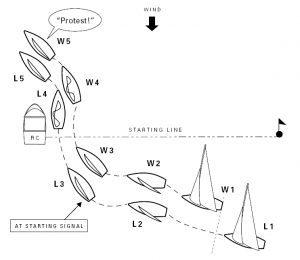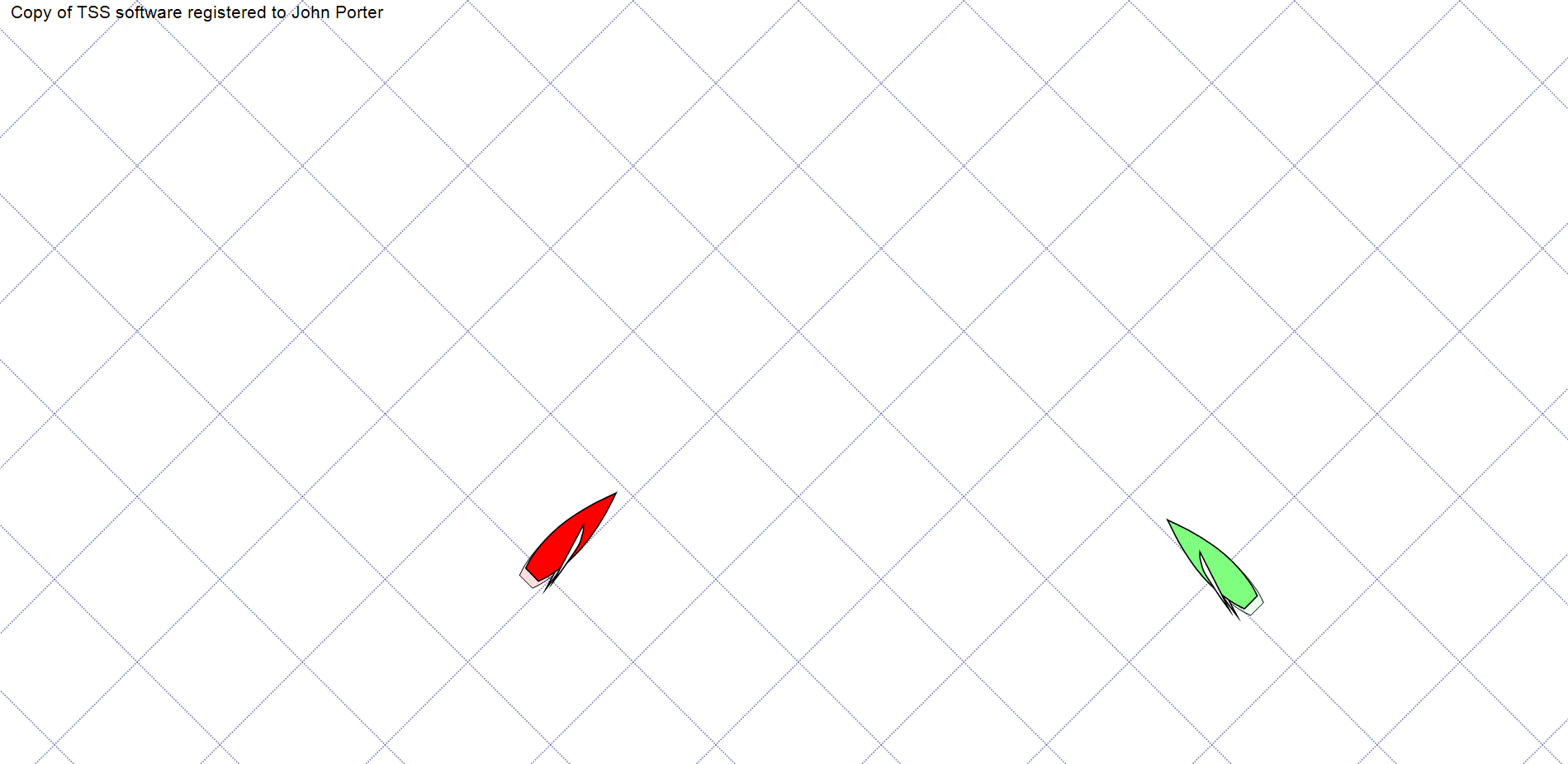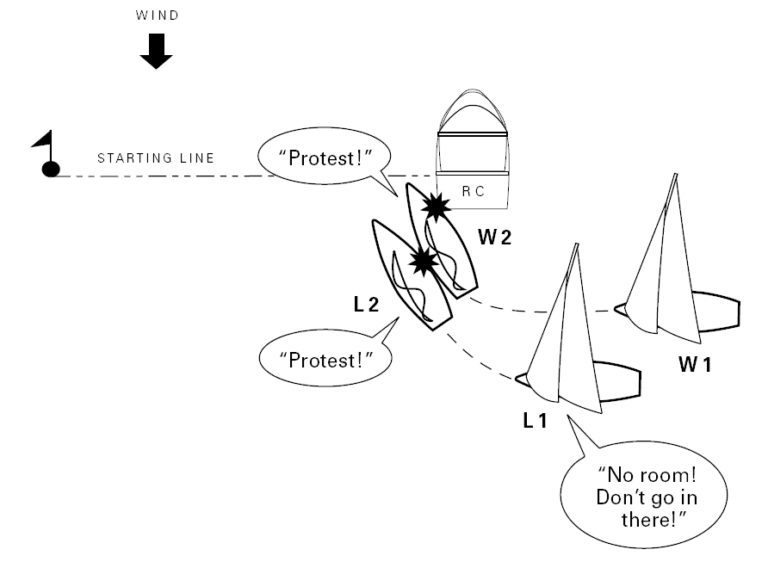Do have a sailing story, news, or helpful sailing-related information to share?
Please contact P/C Steve Harris to have it included. We’d love to hear from you.
Each week this season, we will offer a “quiz” question regarding the Racing Rules of Sailing. Read the scenario below, formulate your answer, then move your mouse over the box to reveal the correct answer. Need further explanation? Each week this season, we will offer a “quiz” question regarding the Racing Rules of Sailing. Read the scenario below, formulate your answer, then move your mouse over the box to reveal the correct answer. Need further explanation? Two 18-foot boats, L (a leeward boat) and W (a windward boat), are approaching the left-hand end of the starting line, which is a 16-foot powerboat. When W is three lengths from the end of the line, L becomes overlapped on W to leeward from clear astern. There are six seconds to go before the starting signal. L slowly luffs and W keeps clear. As L reaches close-hauled, the starting signal is made. L is a boat length from the powerboat and will not clear it sailing close-hauled. She luffs to head to wind, shooting up and around the powerboat, and then bears away to a close-hauled course. W keeps clear through- out, and protests L for sailing above close-hauled after the starting signal. Boat W’s protest is disallowed. The 16-foot powerboat ranks as both a “mark” and an “obstruction” to the 18-foot boats (see the definitions Mark and Obstruction). The preamble to Part 2, Section C, At Marks and Obstructions, states that the rules of Section C, which include rule 18, Mark-Room, and rule 19, Room to Pass an Obstruction, do not apply “at a starting mark surrounded by navigable water.” Therefore the situation is governed by the rules of Sections A and B. Each week this season, we will offer a “quiz” question regarding the Racing Rules of Sailing. Read the scenario below, formulate your answer, then move your mouse over the box to reveal the correct answer. Need further explanation? In a post-race conversation, the helmsman of Boat X complains to a member of the protest committee that he clearly saw another boat in his race, Boat Y, touch the gybe mark and not take a penalty turn. The protest committee member therefore decides to protest Y for an alleged breach of rule 31, Touching a Mark. Y is informed that she is being protested, and the protest is filed within the time limit. The protest is not valid and therefore its hearing should be closed under rule 63.5, Validity of the Protest or Request for Redress. Rule 60.3, Right to Protest; Right to Request Redress or Rule 69 Action, governs the action by the protest committee in this case, and states that a protest committee cannot protest as a result of a report from a person who has a conflict of interest (with an exception that doesn’t apply in this case). Because all the requirements for a protest have not been met, the protest is not valid. When competitors witness alleged breaches of the rules, and they want the incident to go to a hearing, they must act themselves according to rule 60.1, Right to Protest; Right to Request Redress or Rule 69 Action. Each week this season, we will offer a “quiz” question regarding the Racing Rules of Sailing. Read the scenario below, formulate your answer, then move your mouse over the box to reveal the correct answer. Need further explanation? Red and Green are sailing upwind. Red starts to bear off to go behind Green. Green also bears off. Red then heads up, and Green also heads up. There was no contact. Green broke Rule 16.1, Changing Course, which states, in part, that when a port-tack boat is keeping clear by passing astern of a starboard-tack boat, the starboard-tack boat shall not change course if as a result the port-tack boat would immediately need to change course to continue keeping clear. At position 3, Green changed course, forcing Red to immediately change course to keep clear. Note that at position 2, even though Green changed course, no foul occurred, since Red did not immediately need to change course in response. This quiz was borrowed from the Inland Lake Yachting Association‘s #FairSailing initiative Each week this season, we will offer a “quiz” question regarding the Racing Rules of Sailing. Read the scenario below, formulate your answer, then move your mouse over the box to reveal the correct answer. Need further explanation? Two 25-foot boats, L (a leeward boat) and W (a windward boat), are approaching the right-hand end of the starting line, a 30-foot powerboat, to start an upwind leg. Both boats are beam reaching, with L on a course to pass one length to leeward of the race committee boat. Twenty seconds before the starting signal and when two lengths from the race committee boat, L hails, “No room! Don’t go in there!” to W. Both boats hold their courses until W is overlapped to leeward of the race committee boat. At that point L luffs and W makes con- tact nearly simultaneously with both L and the committee boat. There is dam- age to the starboard side of L but not serious damage. Both boats protest each other. You are on the protest committee; how would you decide this? Boat L is penalized under rules 14, Avoiding Contact, and 16.1, Changing Course. The preamble to Part 2, Section C, At Marks and Obstructions, states that rules 18, Mark-Room, 19, Room to Pass an Obstruction and 20, Room to Tack at an Obstruction, do not apply “at a starting mark surrounded by navigable water or at its anchor line from the time the boats are approaching them to start…”. Therefore the situation is governed by the rules in Sections A and B. At the time W becomes overlapped to leeward of the race committee boat, she is keeping clear of L in compliance with rule 11, On the Same Tack, Overlapped (Section A rule). Rule 16.1 requires L, as a right-of-way boat, to give W room to keep clear of her when she changes her course (Section B rule). When L luffs, there is not room (space) for W to comply with the Part 2 rules and rule 31, Touching a Mark, due to the physical presence of the race committee boat (see the definition Room). Therefore L breaks rule 16.1. W breaks rules 11 and 31 but is exonerated (freed from penalty) by rule 43.1(b), Exoneration.Racing Rules Weekly Quiz
something we can discuss on the porch on Sunday.
This Week’s Question
During the hearing of a request for redress, the protest committee learns that Boat X has touched a mark during the race. The protest committee protests X, giving her time to prepare, etc., holds a protest hearing with X in attendance, and disqualifies her for breaking rule 31, Touching a Mark. X appeals. You are on the appeals committee; how would you decide this?
Answer
Boat X’s appeal is sustained and the protest committee’s decision is reversed. Boat X is reinstated in the race. Rule 60.3(a), Right to Protest; Right to Request Redress or Rule 69 Action, says that the protest committee cannot protest a boat as a result of information in a request for redress.
This quiz was excerpted from Dave Perry’s 100 Best Racing Rules Quizzes available from US Sailing. For a comprehensive explanation of the rules, read Dave Perry’s Understanding the Racing Rules of Sailing through 2024, which is also available from US Sailing. Permission to reprint this quiz for non commercial use is granted by the author. Racing Rules Weekly Quiz
something we can discuss on the porch on Sunday.
This Week’s Question
You are on the protest committee: how would you decide this?
Answer
L becomes overlapped to leeward from clear astern of W. Therefore, rule 17, On the Same Tack; Proper Course, requires her to not sail above her proper course. Before the starting signal L has no proper course (see the definition Proper Course); therefore she is free to sail up to head to wind, provided that when she changes course she gives W room to keep clear (rule 16.1, Changing Course).
After the starting signal, L is required to not sail above her proper course. In this case her “proper course” (the course she would choose in order to sail the course and finish as soon as possible in the absence of W) is to luff head to wind, coast past the powerboat and then bear away to a close-hauled course (see the definition Proper Course). L sails no higher than this course, and there- fore does not break rule 17. And while she is changing course, L gives W room to keep clear under rule 16.1 as demonstrated by W’s performance. W correctly keeps clear under rule 11, On the Same Tack, Overlapped.
This quiz was excerpted from Dave Perry’s 100 Best Racing Rules Quizzes available from US Sailing. For a comprehensive explanation of the rules, read Dave Perry’s Understanding the Racing Rules of Sailing through 2024, which is also available from US Sailing. Permission to reprint this quiz for non commercial use is granted by the author.Racing Rules Weekly Quiz
something we can discuss on the porch on Sunday.
This Week’s Question
You are on the protest committee: how do you decide this?
Answer
This quiz was excerpted from Dave Perry’s 100 Best Racing Rules Quizzes available from US Sailing. For a comprehensive explanation of the rules, read Dave Perry’s Understanding the Racing Rules of Sailing through 2024, which is also available from US Sailing. Permission to reprint this quiz for non commercial use is granted by the author.Racing Rules Weekly Quiz
something we can discuss on the porch on Sunday.
This Week’s Question
Which boat should promptly take a penalty?
Answer
Learn more at sailzing.comRacing Rules Weekly Quiz
something we can discuss on the porch on Sunday.
This Week’s Question
Answer
L also breaks rule 14 for failing to avoid a collision, and is penalized under that rule because the contact results in damage to herself. However, from the time L begins to luff, it is not possible for W to avoid contact; therefore W does not break rule 14.
Had L wanted to prevent W from passing between her and the committee boat, she should have luffed sooner while W was still able to respond to her luff without making contact with the committee boat (see World Sailing Cases 114 and 146).
This quiz was excerpted from Dave Perry’s 100 Best Racing Rules Quizzes available from US Sailing. For a comprehensive explanation of the rules, read Dave Perry’s Understanding the Racing Rules of Sailing through 2024, which is also available from US Sailing. Permission to reprint this quiz for non commercial use is granted by the author.
